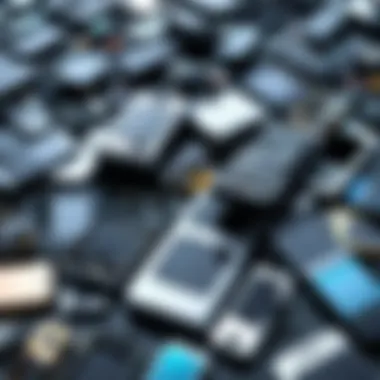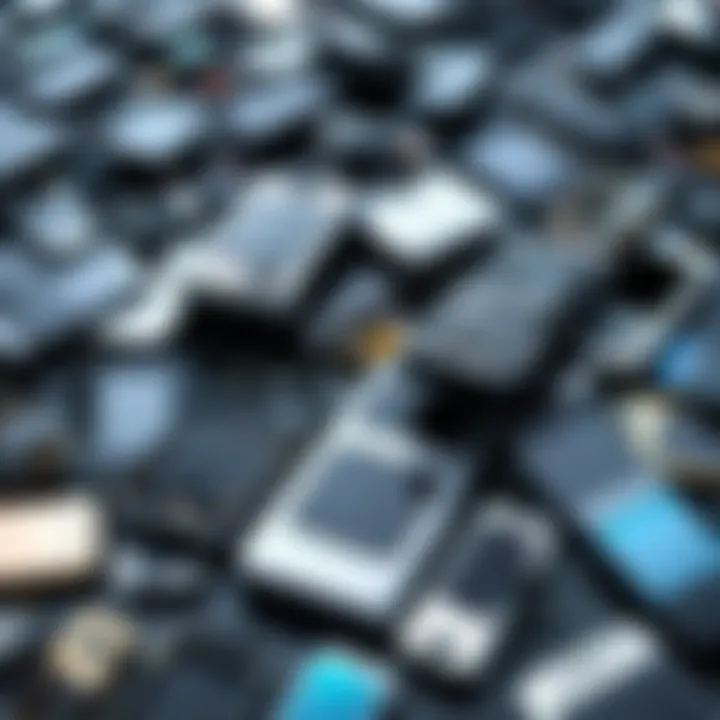Proper Disposal of Cell Phones: Challenges and Responsibilities


Intro
In a world where technology evolves quicker than a flash of lightning, we find ourselves in a constant cycle of upgrading our gadgets. Cell phones, once a luxury, have become necessities for many. As the market floods with newer models and innovative features, older devices get pushed aside, often ending up in drawers or, worse, in landfills. This article delves into the underlying issues associated with this trend, emphasizing the importance of proper disposal of cell phones.
With an estimated 50 million tons of e-waste produced globally each year, the consequences of neglecting responsible practices are staggering. The environmental impacts are severe, including contamination of soil and water resources due to hazardous materials like lead and mercury found in phones. On a human scale, the mismanagement of this waste directly threatens public health, with exposure linked to a variety of ailments.
Together, we will navigate the challenges that come with the disposal of cell phones today. We'll explore the options available to consumers for responsible recycling, the roles of manufacturers in producing sustainable devices, and the necessary legislative actions that can promote proper electronic waste management.
By understanding the different facets of this topic, individuals and organizations can play an active role in reducing e-waste and fostering a more sustainable future for generations to come. Let's take this journey step by step, bringing light to a pressing issue that demands our immediate attention.
Prolusion to Cell Phone Disposal
The disposal of cell phones is a pressing issue that straddles the intersection of consumer responsibility and environmental sustainability. In a world where technology changes faster than a flick of a switch, our reliance on mobile devices grows exponentially. This section serves to elucidate the intricate landscape of cell phone disposal, emphasizing its vital importance in the broader context of ecological consciousness and public health.
As smartphones become obsolete within short life cycles, the waste they generate piles up. In many ways, failing to properly dispose of these devices can lead to dire consequences, not just for the individual consumer but also for our planet at large. Socially, consumers need to recognize that their choices about disposal can ripple outwards, causing substantial impacts on communities and ecosystems.
Moreover, there are practical benefits to understanding and engaging in proper disposal methods. Consumers who are well-informed are more likely to utilize recycling options that keep hazardous materials out of landfills, just as they contribute to a circular economy that reuses valuable components. Such awareness fosters a culture of responsible consumption and environmental stewardship. Let's dive deeper into the specifics of electronic waste and the statistically telling trends in cell phone usage that drive this conversation.
Understanding Electronic Waste
When we talk about electronic waste, or e-waste, we are referencing discarded electrical or electronic devices, including cell phones. It's often easy to overlook the complexities behind what happens to old devices when they are tossed aside. The truth is, these gadgets contain a cocktail of metals and materials that can be beneficial but equally hazardous. Components like lithium, cobalt, and even lead can seep into the ground if improperly disposed of, causing terrestrial and aquatic systems to suffer.
Each year, an astounding number of cell phones are replaced, leading to millions of tons of e-waste. This incessant churn creates a problem that challenges current waste management systems to cope. Globally, countries are grappling with how to handle this growing issue, often lacking the infrastructure necessary to manage it responsibly.
Statistics and Trends in Cell Phone Usage
The rise in cell phone usage is remarkable, with more than 6 billion subscribers as of 2023. This number continues to climb, suggesting that nearly 80% of the global population owns a mobile device. With rapid advancements in technology and consumer demand for the latest gadgets, it’s no wonder that individuals often retire their devices in favor of something newer or flashier.
However, this trend must be weighed against e-waste statistics which paint a grim picture. According to the Global E-waste Monitor, over 50 million tons of e-waste were generated in 2019 alone, with projections pointing upward. A notable and alarming trend is that only about 20% of this waste is formally recycled. This signals a colossal opportunity lost, not just for resource recovery but for ecological safety. When the burden of e-waste continues to mount unchecked, it becomes incumbent upon consumers, manufacturers, and legislators alike to devise solutions that resonate with the urgency of this unfolding crisis.
The Environmental Impact of Improper Disposal
Proper disposal of cell phones isn't just a matter of personal responsibility; it has far-reaching consequences that affect the environment. Failing to dispose of old devices correctly can lead to various detrimental impacts, particularly when one considers the toxic materials present in these gadgets.
Toxic Materials in Cell Phones
Cell phones are often touted as technological marvels, but they contain an array of materials that can pose a significant threat when improperly discarded. For instance, most smartphones comprise lead, mercury, cadmium, and lithium. These substances can leach into soil and groundwater, resulting in contamination that can persist for years. Just think about it: when a phone gets tossed into a landfill, it’s not just an eyesore; it’s a potential source of hazardous waste.
- Lead can cause neurological issues and developmental problems in children.
- Mercury contributes to air pollution and can harm aquatic life.
- Cadmium, which affects the kidneys and bones, remains in the environment for an exceptionally long time.
- Lithium, while essential for rechargeable batteries, can cause lithium-ion batteries to swell and burst if they degrade, creating fire hazards and potential environmental risks.
Effects on Landfills and Water Systems
Cell phones are often found mixed in with general waste, leading to significant complications in landfills. Even modern facilities equipped with sophisticated systems may struggle to manage electronic waste effectively. When phones break down, the toxic substances can seep into nearby water sources, creating a ripple effect that jeopardizes entire ecosystems. It’s akin to throwing a stone into a pond—ripples spread out, affecting larger areas.
Research indicates that only about 20% of electronic waste is recycled globally. This means the vast majority lands up where it shouldn’t, exacerbating the pollution problem. Landfills also require space that could otherwise be allocated to sustainable practices, contributing further to the environmental crisis.
- Water Pollution: Toxic elements can wash through soil and contaminate water bodies.
- Soil Contamination: Harmful elements may remain in the soil, affecting agriculture and wildlife.
Global Implications of Electronic Waste
The issue of electronic waste is not contained within national borders; it’s a global challenge. Countries like India and China often become dumping grounds for e-waste from developed nations. This not only poses a health hazard to local populations but also places strain on their already stretched environmental resources. You might ask, why is that a problem? It’s a question of equity and responsibility.
Disparities in waste management practices lead to uneven consequences on a global scale. Areas receiving this waste may lack the infrastructure to safely handle toxic materials, leading to human suffering and environmental degradation. Other straightforward implications include:
- Inadequate health and safety standards increase risks for workers handling e-waste.
- Increased greenhouse gas emissions due to inefficient dismantling practices.
"Ignoring the environmental impact of improper cell phone disposal is like playing chess without regard for the consequences of each move—eventually, you’ll find yourself losing the game."


Affording attention to the environmental impacts of cell phone disposal is unequivocally necessary. It underscores the shared responsibility individuals and nations have in ensuring that technology does not become a liability. This awareness can galvanize change, fostering more responsible consumer behavior and encouraging companies to adopt sustainable practices.
Legal and Regulatory Framework
Understanding the legal and regulatory framework surrounding electronic waste disposal is crucial for both consumers and manufacturers. This area influences how cell phones are managed at the end of their life cycle, ensuring that disposal practices align with environmental standards while also protecting public health. Effective policies help reduce the risks associated with improper disposal, which can have far-reaching consequences.
Policies Governing Electronic Waste Disposal
The landscape of electronic waste disposal is governed by a myriad of policies that vary from region to region. These regulations are essential in setting the standards for how discarded devices are handled. For instance, some local governments have established specific guidelines to manage e-waste, requiring that it be disposed of at designated collection points rather than in general landfills. This helps prevent toxic substances from leaching into the soil and water.
Key policies typically address:
- Collection and recycling: Mandating the setup of designated drop-off points or events for e-waste.
- Public awareness: Instilling educational outreach programs to inform the public about the hazards of electronic waste and how to dispose of it responsibly.
- Reporting and compliance: Regulatory measures that require manufacturers and retailers to report on their e-waste management practices.
The effectiveness of these policies hinges not only on their existence but also on their enforcement. Policymakers need to ensure that there are penalties in place for non-compliance, encouraging individuals and businesses to adhere to responsible disposal methods. The dialogue between consumers, lawmakers, and industries is vital to keeping these policies up-to-date and relevant.
Extended Producer Responsibility Legislation
Extended Producer Responsibility (EPR) legislation is a transformative approach that shifts the burden of waste management from consumers to producers. Under this framework, manufacturers are held accountable for the entire lifecycle of their products, including the disposal phase.
This means that companies must find sustainable ways to collect and recycle their products once they reach the end of their useful life. Such legislative measures encourage manufacturers to design products that are easier to disassemble and recycle, which in the long run minimizes environmental impact.
EPR legislation often provides incentives for manufacturers who implement effective take-back schemes, like
- Financial support for recycling programs: This might include grants to municipalities for establishing e-waste collection facilities.
- Market access for recycled materials: Encouraging industries to use recycled materials in new products, creating a more circular economy.
Implementing EPR also has implications on consumer behavior. With producers taking responsibility, consumers may become more aware of their options for disposal, leading to better recycling rates and actively participating in a more sustainable future.
"Without proper policies, the nightmare of e-waste will only continue to grow. We all have a role to play, but it starts with strong regulatory frameworks." - Environmental Advocate
The legal and regulatory framework regarding cell phone disposal thus serves as a critical backbone in promoting responsible behaviors and practices among all stakeholders involved.
Options for Responsible Disposal
Responsible disposal of cell phones stands as a pressing issue in the e-waste sphere. It doesn’t just boil down to tossing an old device in the trash; these decisions carry long-term implications for the environment and public health. By adopting responsible practices, consumers and producers alike can mitigate risks linked to electronic waste. From protecting precious natural resources to promoting recycling initiatives, understanding various disposal options empowers individuals to make informed choices. Here, we explore practical methods that benefit not only the planet but also foster community engagement.
Manufacturer Take-Back Programs
Manufacturers are increasing their role in e-waste management. Companies like Apple and Samsung have initiated take-back programs enabling consumers to return their used devices. These programs often provide incentives, such as trade-in credits towards new purchases. This creates a win-win scenario: individuals get monetary benefits while responsibly recycling their phones.
Some key aspects to consider include:
- Ease of Use: Typically, returning phones is straightforward. Individuals can either mail their devices back or drop them off at designated locations.
- Data Safety: Reputable manufacturers usually handle data deletion before reconditioning devices. This alleviates concerns about personal data breaches.
- Sustainability Goals: Supporting these programs aligns consumers with broader sustainability movements.
Local Recycling Centers and Initiatives
Another viable option is utilizing local recycling centers. Many municipalities have set up e-waste drop-off points which facilitate environmentally friendly disposal practices. Recycling centers like those offered by Goodwill and specialized facilities, often have the equipment to safely dismantle and recycle electronic devices.
When engaging with local recycling initiatives, consider the following benefits:
- Community Focus: By participating, you reinforce local efforts to handle waste responsibly, promoting community engagement.
- Resource Recovery: These centers often recover valuable materials that can be reused in manufacturing new products, thus reducing demand for raw materials.
- Environmental Protection: Proper recycling helps keep hazardous materials, such as lead and mercury, out of landfills and preserves the surrounding ecosystems.
Donation and Resale Options
Donating or reselling used cell phones not only extends the device's life but also supports individuals or organizations in need. Many charities eagerly accept functional devices, and platforms like eBay and Facebook Marketplace facilitate the resale of older models.
Here’s why this method proves beneficial:
- Maximizing Value: Rather than letting old devices collect dust, consumers can turn them into cash or donations for a cause they care about.
- Promoting Accessibility: Donating to schools or non-profits provides access to technology that otherwise might be out of reach for some.
- Reducing E-Waste: By giving devices a second life, individuals actively contribute to reducing the overall volume of e-waste, aiding in environmental preservation.


"Making responsible choices in cell phone disposal can yield significant benefits — every small action counts towards a much larger goal."
Consumer Responsibilities in Cell Phone Disposal
In an age where technology surrounds us, understanding the ramifications of our digital choices becomes crucial. When it comes to cell phones, responsible disposal goes beyond just tossing them into any recycling bin; it's about understanding our obligation as consumers to the environment and society. With millions of phones being discarded every year, consumer awareness and responsibility could significantly mitigate the adverse effects of electronic waste.
Each discarded cell phone can be a ticking time bomb of issues. From the toxic materials inside to the sensitive data still lingering on devices, neglecting a proper disposal method can have wide-reaching consequences. Thus, a sense of accountability must be ingrained in consumers to ensure that their discarded gadgets do not turn into liabilities. There are specific elements to consider when addressing consumer responsibilities, including data security, environmental impact, and the processes we must adhere to when recycling.
Data Security Considerations
One glaring concern when disposing of a cell phone is protecting personal data. Many people think they can just delete files or perform a factory reset, but that’s often not enough. Harmful realities, such as identity theft and data breaches, can rear their ugly heads if sensitive information ends up in the wrong hands.
To cover your bases:
- Backup data: Before saying goodbye to your device, make sure to save essential files and data. You can use cloud storage or an external hard drive for this.
- Factory reset is a must: Just like cleaning out a closet, don’t just shove everything towards the back. Go through your phone and perform a proper factory reset to erase all personal items.
- Data wiping software: Consider using specialized software for a more thorough data wipe. Programs like DBAN can satisfyingly obliterate any data lingering on your device, adding that extra layer of security.
At the end of the day, it’s not just about recycling; it’s about ensuring your information does not go tumbleweeding into the wrong hands.
Preparing Phones for Recycling
Once data security has been handled, prepping the phone for recycling is the next logical step. Just like you wouldn’t hand over a pair of shoes without taking them off first, you need to be sure your phone is ready to be sent away.
Preparation involves a few simple actions:
- Remove accessories: Snatch off any cases, screen protectors, and additional attachments. These items may not be recycled together with the phone and could disrupt recycling processes.
- Take out the battery: For certain phones, it might be necessary to remove the battery as part of recycling protocols. Always check with local guidelines about battery disposal.
- Clean it up: Give your phone a good wipe down. While it’s not an absolute requirement, cleaning can help facilitate the recycling process and make it easier for recyclers to assess the phone's condition.
Not only does proper preparation help recycle the phone, it also fosters a community-minded attitude toward e-waste handling. Knowing that each effort contributes to a healthier planet might just make the task at hand more significant than it seems.
The act of recycling our old cell phones is more than a simple chore; it’s a demonstration of our commitment to reducing e-waste and protecting our environment for future generations.
In summary, the consumer’s role in phone disposal is pivotal. From securing data to prepping devices for recycling, the responsibility lies with us to ensure that when our phones reach their end of life, they do so in a manner that respects the our shared environment and each other.
Innovations in Recycling Technology
In today's rapidly changing technological landscape, the need for innovative recycling solutions is more pressing than ever. As cell phones continue to proliferate, the challenge of effectively processing discarded devices has sparked a wave of ingenuity in the recycling industry. The innovations in this field not only promise to improve the efficiency of recycling processes but also aim to make them more environmentally friendly. By harnessing new technologies, businesses can tackle the complex issues of electronic waste better than ever before.
Emerging Recycling Techniques
One of the most notable advancements in recycling technology is the development of advanced methods that significantly enhance the recovery of valuable materials from old phones. For example, hydrometallurgical processes use aqueous solutions to recover metals such as gold, silver, and copper. This technique stands out because it is less harmful to the environment than traditional smelting methods.
Additionally, bioleaching has gained attention as an eco-friendly option. It employs microorganisms to extract metals from electronic waste, offering a lower carbon footprint and mitigating the use of harmful chemicals. Companies around the globe are increasingly adopting these methods, fostering a more sustainable industry that reduces waste while maximizing resource recovery.
- Key Benefits of Emerging Techniques:
- Enhanced recovery rates of precious metals
- Reduced environmental impact
- Lower operational costs
The potential of these techniques is vast, yet they require investment and careful implementation to be fully realized. Both manufacturers and waste management companies must collaborate to turn these innovative ideas into practice.
Role of Automation in E-Waste Processing
Automation has also made significant strides in e-waste processing, transforming how we handle outdated devices. Advanced robotics and artificial intelligence play a crucial role in sorting and disassembling cell phones in recycling facilities. These technological tools can identify materials swiftly, bringing about a faster, more accurate processing method. This not only increases the throughput of recycling operations but also minimizes the risk of human error during sorting.
Using automation can greatly streamline the entire recycling chain, from initial collection through final recovery of usable components. As a result, companies can improve overall efficiency and reduce costs associated with manual labor.
Furthermore, automated systems can be designed to handle hazardous materials with care, ensuring that the environmental impact is kept to a minimum.
"The integration of automation in e-waste processing signifies a substantial leap toward achieving our recycling goals. It holds the key to transforming the industry's capabilities."
In summary, the innovations in recycling technology, especially emerging techniques and automation, pave the way for a more sustainable approach to cell phone disposal. As these advancements gain traction, it's crucial for all stakeholders—from manufacturers to consumers—to stay informed and engaged in promoting responsible e-waste management practices.


Case Studies on Effective Disposal Initiatives
Exploring real-world examples of effective cell phone disposal initiatives highlights not only the challenges faced by various nations but also the solutions they have devised. This section looks into significant successes achieved in different parts of the globe, demonstrating that with the right approach and commitment, communities can make a sizeable impact on e-waste management.
Success Stories from Various Countries
- Sweden – A Pioneer in E-Waste Recycling
Sweden is often regarded as a leader in environmental sustainability and waste management. The country has implemented a comprehensive recycling program that applies to electronic devices, including cell phones. Citizens are encouraged to drop off their old devices at designated recycling stations. The local government provides a monetary incentive, rewarding users for each device returned. This not only reduces the amount of waste in landfills but also promotes a culture of recycling among the populace. - Japan – Innovative Collection Schemes
Japan has integrated technology with recycling efforts. The nation uses automated vending machines for the collection of old phones, making disposal more convenient for residents. Users can simply insert their old devices, and in return, they receive points that can be redeemed for discounts at popular stores. This initiative has successfully garnered public participation and increased recycling rates significantly. - India – Community-driven Awareness Programs
In India, a grassroots movement has emerged wherein local non-profits educate communities about the hazards of improper e-waste disposal. These organizations conduct workshops, emphasizing the importance of responsible recycling and its benefits to both the environment and health. They facilitate collection drives, making it easier for people to dispose of their old phones safely.
These success stories reveal the immense potential that exists when communities come together to address the issue of e-waste.
Lessons Learned for Future Practices
The initiatives seen worldwide offer numerous insights that can be utilized to refine and enhance cell phone disposal practices moving forward:
- Public Engagement is Key: Campaigns should focus on engaging the public through awareness and rewards. When people feel that their actions are recognized and rewarded, they are more likely to participate in recycling programs.
- Innovative Solutions Foster Participation: Using technology to streamline the disposal process can greatly enhance user engagement. Automated systems or smartphone apps can simplify the process and make recycling a convenient choice.
- Education Drives Responsible Disposal: Building awareness about the impact of electronic waste is crucial. Educational initiatives can empower individuals with knowledge, leading to more environmentally responsible behaviors.
In sum, effective disposal initiatives require a blend of community involvement, innovative approaches, and educational outreach. By learning from successful case studies, future efforts can be tailored to better fit local needs while also enhancing global e-waste management strategies.
The Future of Cell Phone Disposal
Looking ahead, it is crucial to consider the evolving landscape of cell phone disposal. As technology progresses, so too must our methods for dealing with obsolete electronic devices. The stakes are high; not only do consumer habits need to shift, but manufacturers and regulators must adapt too. Ignoring these aspects means exacerbating the already pressing issue of electronic waste.
Trends in Sustainable Materials
One significant shift we are witnessing is the increasing use of sustainable materials in cell phone manufacturing. Companies are becoming more aware of their responsibility to not only consumers but also the environment. Materials such as bioplastics and recycled metals are starting to find their way into devices, which can greatly reduce their overall environmental impact.
For instance, some manufacturers are experimenting with manufacturing processes that incorporate recycled aluminum. This not only reduces the need for virgin metal extraction but also lessens the carbon footprint associated with production. Additionally, innovations such as modular phone designs are surfacing, allowing for easier repairs and updates instead of complete replacements. The trend towards sustainable materials isn't just a marketing gimmick; it's a preemptive strike against the e-waste crisis.
- Key Benefits of Sustainable Materials:
- Reduced environmental pollution during production
- Lower energy consumption in manufacturing processes
- Enhanced recyclability at end-of-life, making disposal easier
Expected Changes in Legislation
As we continue to grapple with the e-waste conundrum, legislative measures will likely become more stringent. Governments around the world are beginning to recognize the necessity of robust frameworks for electronic waste management. This might involve tightening the regulations that govern the disposal of products and holding manufacturers accountable for the lifecycle of their devices.
Countries such as the European Union are leading the charge, with laws that push for a more circular economy, mandating that companies take back old products and ensure they are properly recycled. We can expect similar measures to be adopted in more regions, promoting accountability among manufacturers.
"Proper legislative frameworks can incentivize technological advancements, fostering a culture of responsibility toward electronic waste management."
- Key Aspects to Anticipate in Legislation:
- Implementation of stricter fines for improper disposal
- Emphasis on transparency regarding e-waste practices by manufacturers
- Promotion of extended producer responsibility (EPR) models
To sum up, the future of cell phone disposal holds promise through innovative materials and anticipated changes in legislation. Adopting sustainable practices can help curb the growing e-waste problem, while forward-thinking policies compel all stakeholders—manufacturers, consumers, and regulators—to work collectively towards a more sustainable approach. Taking these steps isn't merely about compliance; it’s about future-proofing our planet.
Ending
As we draw the curtain on the subject of cell phone disposal, it's clear that responsible disposal isn't just a buzzword; it's a pressing obligation that impacts future generations. The stakes are high, as improper disposal poses serious environmental hazards and health risks. With every discarded phone adds its share to the growing heaps of e-waste, there is an urgent need to grasp the depth of this issue and act accordingly.
Summarizing the Importance of Responsible Disposal
Responsible disposal of cell phones significantly helps in reducing the volume of electronic waste. When handled correctly, recycling phones can reclaim valuable materials like gold, silver, and rare earth metals. Instead of going to a landfill, these components can be reused, thus conserving natural resources and minimizing the carbon footprint.
Moreover, the environmental implications of ignoring e-waste disposal protocols are profound. Toxic substances such as lead and mercury can seep into the soil and water systems if not managed properly. This risk underscores the need for awareness among consumers regarding correct disposal methods. By acting responsibly, individuals not only mitigate harmful impacts but also contribute to a broader cultural shift toward sustainability that can guide future innovations in technology and waste management.
“We do not inherit the earth from our ancestors; we borrow it from our children.” This quote resonates profoundly in the context of e-waste, emphasizing the essential responsibility we hold toward our planet.
A Call to Action for IT Professionals
IT professionals play a crucial role in championing the cause of sustainable electronics disposal. It's not just about setting up a protocol within corporate frameworks, but also engaging in community outreach to educate consumers on best practices for disposal.
In every tech conference or meet-up, there lies an opportunity to discuss and circulate knowledge regarding e-waste. It’s essential to advocate for manufacturer take-back programs, create engaging workshops, or even collaborate with local recycling initiatives to enhance collective impact. Encouraging peers and the public to make informed choices can create a ripple effect that extends far beyond individual actions.
In essence, IT professionals have a unique platform to influence policies and practices around e-waste. By stepping up and taking the lead, they can help carve a more sustainable future. Each one of us has the power to make informed decisions and inspire those around us, ensuring we treat our planet with the respect it deserves.



